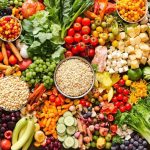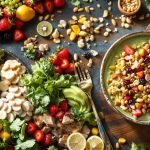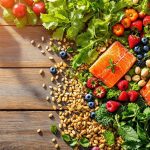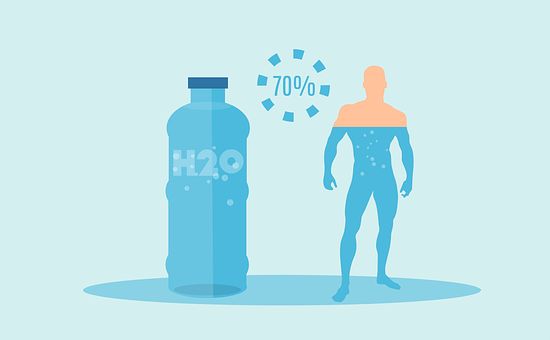To achieve balanced nutrition for an active lifestyle, you need to focus on a variety of nutrient-dense foods, proper hydration, and mindful portion control. Aim for balanced meals that include complex carbohydrates, lean proteins, and healthy fats to enhance performance and support muscle recovery. Hydrate adequately before, during, and after exercise to prevent dehydration. Incorporate 3 to 5 food groups in each meal and use portion control to maintain energy balance. By following these strategies, you can fuel your energy needs and maintain overall health. Continuing on this path will help you uncover more tailored strategies for sustained success.
Key Points
- Eat Balanced Meals: Include carbohydrates, proteins, and healthy fats for enhanced performance and recovery, specifically targeting complex carbohydrates and protein intake.
- Hydrate Properly: Drink 6 to 8 glasses of water daily, adjusting for activity level and climate, and prefer water over sugary beverages.
- Follow Macronutrient Guidelines: Aim for carbohydrates (45-65%), protein (10-35%), and fats (20-35%) to support energy and muscle repair.
- Portion Control and Variety: Use the USDA MyPlate guidelines to incorporate a variety of food groups, focusing on nutrient-dense foods and controlling portion sizes.
- Combine Nutrition with Physical Activity: Engage in at least 150 minutes of moderate-intensity aerobic activity weekly, plus muscle-strengthening exercises twice a week, for a comprehensive approach to health and performance.
Eating for Energy and Performance
To enhance your performance and energy levels, consuming a balanced meal rich in carbohydrates, proteins, and healthy fats before workouts is vital. A pre-workout meal that includes complex carbohydrates, such as whole grains or fruits, helps maintain stable blood sugar levels and sustains energy throughout the exercise session. This balanced diet guarantees you have all the necessary nutrients to power your muscles and brain.
You should also focus on post-workout nutrition to aid in muscle recovery and repair. Consuming 10-20 grams of protein within 30 minutes after your workout helps repair muscle tissues and supports overall recovery.
Additionally, hydration is essential for peak performance. Drinking water before, during, and after exercise prevents dehydration and promotes recovery.
Incorporating nutrient-dense snacks, such as nuts, yogurt, or smoothies, between meals helps maintain energy levels and supports overall physical activity throughout the day. Choosing healthy foods that include a mix of carbohydrates, proteins, and healthy fats keeps your energy levels consistent and supports your active lifestyle.
A balanced diet rich in healthy foods is key to maximizing your performance and achieving your fitness goals.
The Importance of Macronutrient Balance
You need a balanced mix of carbohydrates, proteins, and fats to maintain ideal energy levels and support overall bodily functions.
Your carbohydrate intake should make up 45-65% of your daily calories, providing you with the energy you need for high-intensity activities, while protein and fat contribute to muscle repair and hormonal functions.
Carbohydrate Energy Levels
Carbohydrates from whole grains, fruits, and vegetables are preferred because they are digested slowly, which helps maintain stable blood sugar levels and provides prolonged energy. Consuming carbohydrates before exercise enhances performance by providing readily available energy, while post-workout carbohydrates aid in replenishing glycogen stores for recovery.
| Carbohydrate Benefits | High-Quality Sources |
|---|---|
| Primary energy source | Whole grains (oats, brown rice) |
| Prolonged energy release | Fruits and vegetables |
| Replenish glycogen stores | Quinoa and other whole grains |
| Rich in essential nutrients | Includes dietary fiber, vitamins, and minerals |
Incorporating high-quality carbohydrate sources such as oats, brown rice, and quinoa into your diet not only provides energy but also essential vitamins, minerals, and dietary fiber for overall health. Balancing carbohydrate intake with proteins and fats is vital for peak energy levels, muscle repair, and overall macronutrient distribution in a healthy diet.
Protein and Fat Balance
Maintaining a delicate balance of protein, fat, and carbohydrates is vital for supporting overall health and energy levels. You need to verify that you’re getting enough protein to support muscle repair and growth. The recommended daily intake is 0.8 grams per kilogram of body weight for adults, increasing for those engaged in regular exercise.
Healthy fats, particularly unsaturated fats found in sources like nuts, seeds, and avocados, are important for reducing inflammation and providing essential fatty acids that the body can’t produce on its own.
Here are some key points to remember about healthy fats:
- Limit saturated fats: Choose unsaturated fats over saturated fats to reduce the risk of chronic diseases.
- Eat nutrient-dense foods: Focus on lean meats, legumes, fish, and plant-based proteins to support overall health.
- Balance is key: Achieving macronutrient balance is vital for weight management and physical performance.
Hydration Strategies for Active Lifestyles

To fuel your active lifestyle, you need to choose the right beverages and stay properly hydrated.
You can start by aiming for at least 6 to 8 glasses of water daily and adjusting this based on your activity level and the climate you live in.
Choosing Right Beverages
Staying well-hydrated is essential for ideal physical performance and recovery, especially if you’re leading an active lifestyle. Water is the best choice for hydration, as it contains no calories and aids in digestion, nutrient absorption, and temperature regulation during exercise.
Aim for a recommended fluid intake of 6 to 8 glasses of water daily to support your body’s needs.
Choosing the right beverages is vital for peak hydration. Here are a few things to keep in mind:
- Water is best: Stick to water for most hydration needs.
- Sports drinks are for specific needs: Use sports drinks during prolonged, intense activities lasting over an hour to replenish lost electrolytes and carbohydrates.
- Avoid sugary beverages: Limit sodas, fruit juices, and other high-calorie drinks that can lead to weight gain without providing necessary hydration or nutrients.
Carrying a reusable water bottle can encourage regular water intake, making it easier to stay hydrated throughout the day and during workouts.
Staying Properly Hydrated
Drinking enough fluids is essential when you’re physically active, as hydration can greatly boost your endurance and reduce fatigue. Proper hydration is about more than just drinking water; it’s also about maintaining an electrolyte balance, which is critical for ideal muscle function and recovery.
As an active individual, your fluid intake should be higher than that of someone who’s less active. Aim for approximately 6 to 8 glasses of water daily, but adjust this amount based on your exercise level and the weather.
During exercise, it’s important to consume water before, during, and after your workouts to replace lost fluids and maintain electrolyte balance. Additionally, incorporating hydrating foods like fruits and vegetables, such as cucumbers, oranges, and watermelon, can contribute greatly to your overall fluid intake.
Monitoring your hydration status is as simple as checking your urine color; if it’s pale yellow, you’re on the right track. However, darker shades may signal a need for increased fluid intake.
Healthy Meal Planning Essentials
Healthy meal planning essentials revolve around creating a balanced and varied diet that aligns with nutritional needs. To achieve this, you should incorporate at least 3 to 5 food groups from the USDA MyPlate guidelines into each meal, ensuring balanced nutrition and variety.
Key considerations for meal planning include:
- Portion control: Half of your plate should consist of fruits and vegetables, with starchy carbohydrates making up over one-third of your daily food intake, focusing on whole grain options.
- Cooking methods: Opt for baking, steaming, or grilling instead of frying, and utilize herbs and spices for flavor to reduce added fats and calories.
- Meal prep: Prepare meals in advance and create a weekly menu to streamline grocery shopping and avoid unhealthy last-minute choices.
Regularly evaluating your eating habits with tools like the Healthy Eating Check-up and adjusting meal plans to incorporate a diverse range of nutrient-dense foods is vital for overall health and exercise performance.
Healthy eating practices provide the foundation for best nutritional value, ensuring you have the energy necessary for daily activities and physical exercise.
Nutrient-Dense Foods and Portion Control
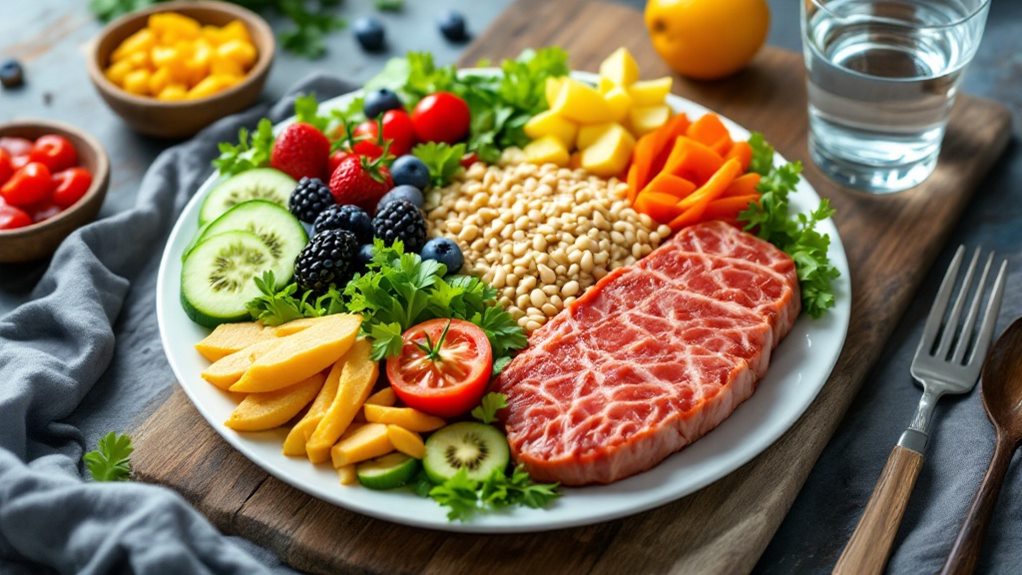
Building on the healthy meal planning essentials you’ve established, focusing on nutrient-dense foods and proper portion control becomes vital. Nutrient-dense foods, such as fruits, vegetables, whole grains, lean proteins, and low-fat dairy, provide essential vitamins and minerals while being lower in calories compared to empty-calorie foods like chips and sweets.
To guarantee you’re getting the right balance, aim for meals to include 3 to 5 food groups from the USDA MyPlate guidelines. This could be a mix of vegetables, lean proteins, and whole grains. Eating a variety ensures you’re getting a broad range of nutrients.
Portion control is also important; using smaller plates and measuring serving sizes can help prevent overeating and guarantee appropriate portion sizes.
For snacks, focus on nutrient-dense options like nuts, yogurt, or fruits to maintain energy levels without excessive calorie intake. Ideally, snacks should consist of 2 to 3 food groups.
Regularly evaluating your portion sizes and food choices will help you stay mindful of your nutrition and support an active lifestyle without compromising your health. By making these simple adjustments, you can enjoy healthy meals while maintaining a balanced diet.
Staying Active With Regular Exercise
Maintaining an active lifestyle through regular exercise is essential for your overall health and fitness. By incorporating physical activity into your daily routine, you’re taking a proactive step towards enhancing your cardiovascular health, building lean muscle mass, and improving your mental well-being.
Engaging in at least 150 minutes of moderate-intensity aerobic activity per week, such as brisk walking or cycling, is important for your cardiovascular health and overall fitness levels. Additionally, incorporating muscle-strengthening activities on two or more days a week helps build and maintain lean muscle mass, which is critical for metabolic health and weight management.
Here are some key benefits of staying active:
- Regular exercise can help prevent chronic diseases, reducing the risk of developing diabetes and heart disease by 30% to 40%.
- Physical activity improves mental health by reducing symptoms of anxiety and depression.
- Activities like gardening, dancing, or playing sports can provide enjoyable ways to stay active, making it easier to integrate movement into daily life and maintain consistent exercise habits.
Combining regular exercise with a diet rich in healthy foods will help you achieve balanced nutrition and maintain a healthy weight.
Stay active, stay healthy.
Balancing Carbohydrates, Protein, and Fat
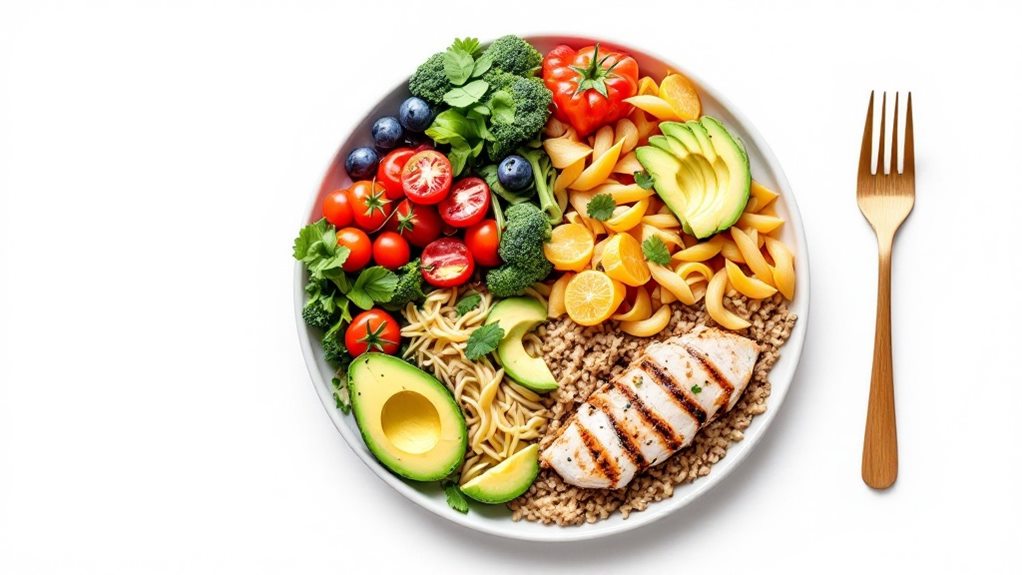
The key is to focus on healthy sources of each macronutrient:
- Complex carbohydrates from whole grains, fruits, and vegetables provide sustained energy and essential nutrients.
- Lean protein sources like poultry, fish, legumes, and low-fat dairy are vital for muscle repair and growth, with a recommended intake of at least 0.8 grams of protein per kilogram of body weight.
- Healthy fats, primarily unsaturated fats from sources like nuts, seeds, avocados, and oils, are important for reducing inflammation and providing essential fatty acids.
Macronutrient Distribution Guide
| Macronutrient | Recommended Range | Healthy Sources |
|---|---|---|
| Carbohydrates | 45-65% | Whole grains, fruits, vegetables |
| Protein | 10-35% | Poultry, fish, legumes, low-fat dairy |
| Fats | 20-35% | Nuts, seeds, avocados, oils |
Preparing Healthy and Nutritious Meals
Preparing healthy and nutritious meals starts with a well-thought-out plan. By preparing meals in advance, you can avoid unhealthy choices and guarantee that you have nutritious options readily available.
This approach also helps streamline grocery shopping, making it easier to stick to your dietary goals.
A key part of your meal plan should involve filling half your plate with a variety of colorful fruits and vegetables. This not only maximizes nutrient intake but also promotes satiety.
Incorporate whole grains, such as brown rice and quinoa, as a staple in your meals, making up one-quarter of your plate for sustained energy and fiber.
Healthy cooking methods are also essential:
- Steaming: Preserves nutrients and flavors.
- Baking: A low-fat alternative to frying.
- Grilling: Enhances flavors with minimal fat.
Incorporating Variety in Your Diet
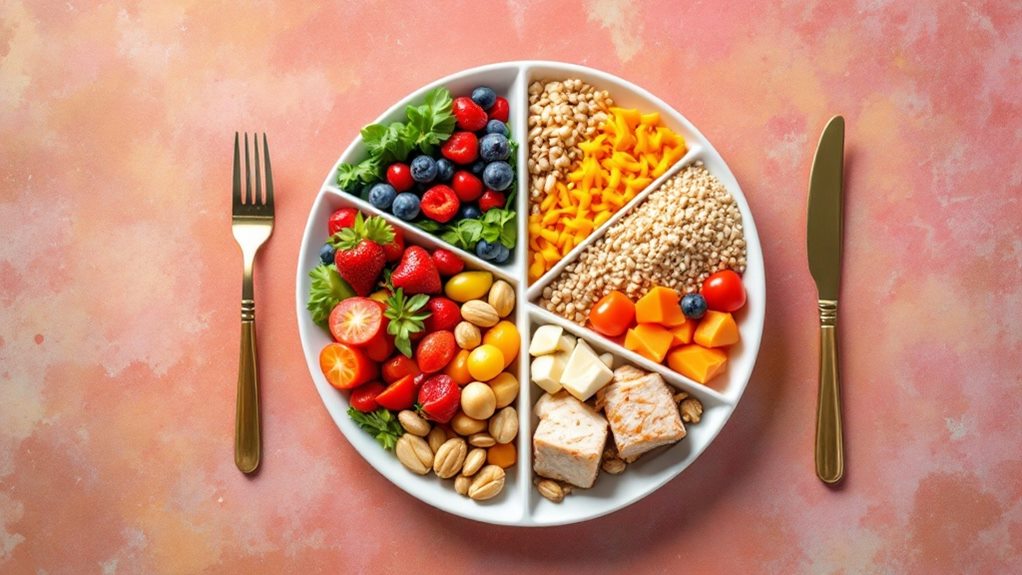
You can guarantee a well-rounded diet by incorporating a variety of foods from all five USDA MyPlate food groups: fruits, vegetables, grains, proteins, and dairy.
Choosing nutrient-rich foods within these groups helps you get the essential vitamins, minerals, and fiber your body needs.
For a balanced diet, focus on selecting whole grains, a diverse range of fruits and vegetables, and various protein sources, including lean meats, fish, legumes, and plant-based options.
Choosing Nutrient-Rich Foods
Incorporating variety into your diet is essential for achieving balanced nutrition. You need to include a mix of different food groups in your meals to guarantee you get all the nutrients you need. The USDA MyPlate guidelines recommend aiming for 3 to 5 food groups in each meal, including fruits, vegetables, whole grains, lean proteins, and low-fat dairy.
To make your meals more nutritious and enjoyable, focus on choosing nutrient-rich foods. Here are some key points to take into account:
- *Healthy portions of fruits and vegetables*:
- Eat at least 5 portions of a variety of fruits and vegetables daily.
- Aim for 80g portions for fresh, canned, or frozen produce and 30g for dried fruit.
- Whole grains and healthy proteins:
- Choose whole grains like brown rice, quinoa, and whole wheat pasta to provide essential fiber and nutrients, making up more than one-third of your daily food intake.
- Include healthy protein sources such as fish, poultry, legumes, and nuts.
- Diverse food choices:
- Experiment with diverse foods within each food group to enhance meal enjoyment and nutrient intake, promoting a more sustainable and enjoyable eating pattern.
Balancing Food Groups
Balancing your food groups is the cornerstone of a healthy diet, guaranteeing that every meal is rich in the variety and nutrient density needed to support overall well-being. To achieve this balance, it’s essential to include a mix of foods from different groups in each meal.
Start by filling half of your plate with a variety of fruits and vegetables, which provide essential vitamins, minerals, and antioxidants for overall health.
Incorporate whole grains, such as brown rice, whole wheat pasta, and quinoa, into your meals, as they offer more fiber and nutrients compared to refined grains. This supports digestive health and sustained energy levels.
Lean protein sources, including fish, poultry, legumes, and low-fat dairy, are also important for muscle repair and growth while minimizing saturated fat intake.
By balancing these food groups, you guarantee you’re getting all the important nutrients needed to maintain a healthy weight and support overall health.
Experimenting with a colorful array of fruits and vegetables further enhances your diet’s nutrient profile, making balancing food groups a key component of balanced nutrition.
Managing Healthy Weight and Nutrition Goals
Achieving and maintaining a healthy weight hinges on a critical balance: managing the calories you consume and the calories you burn. This means focusing on a variety of food groups and incorporating regular physical activity into your daily routine.
To eat healthily, you should aim for a balanced intake of carbohydrates (45-65%), protein (10-35%), and fat (25-35%).
Key strategies for managing your weight include:
- Eating regular meals and healthy snacks: Incorporate 2-3 food groups in each meal to prevent spur-of-the-moment unhealthy choices.
- Portion control: Use smaller dishes and be mindful during meals to prevent overeating.
- Regular physical activity: Aim for at least 150 minutes of moderate-intensity aerobic activity weekly, along with muscle-strengthening exercises at least twice a week.
Incorporating these habits not only supports weight management but also boosts overall health and energy.
Emphasizing whole grains, fruits, vegetables, lean proteins, and healthy fats in your diet guarantees you’re getting the nutrients you need without overdoing it on calories.
In Summary
Achieving balanced nutrition is essential for maintaining an active lifestyle. By focusing on macronutrient balance, proper hydration, and incorporating nutrient-dense foods, you can optimize your energy levels and performance. Significantly, research shows that eating at least 5 portions of fruits and vegetables daily can lower the risk of heart disease, stroke, and some cancers. By balancing your diet and staying hydrated, you’ll be better equipped to meet your fitness goals and maintain overall health and well-being.

